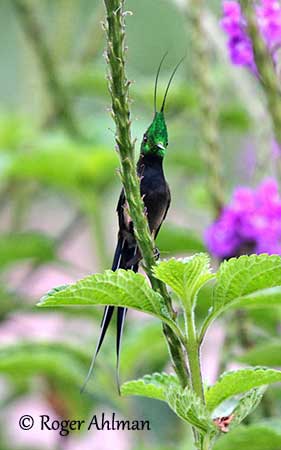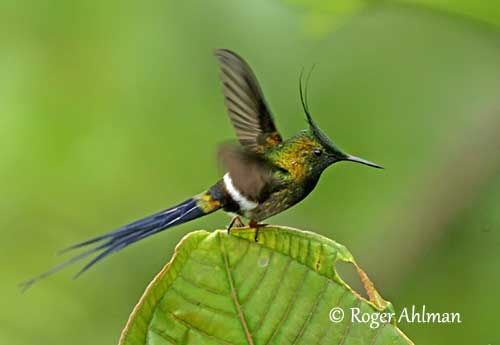
Fr: Coquette de Popelaire
Ang: Wire-crested Thorntail
All: Haubenfadenelfe
Esp: Rabudito Crestado
Ita: Spinuro crestafilosa
Nd: Gekuifde Draadkolibrie
Sd: tofsnålstjärt
Photographer:
Roger Ahlman
Pbase Galleries Peru and Ecuador
Text by Nicole Bouglouan
Sources :
HANDBOOK OF THE BIRDS OF THE WORLD Vol 5 by Josep del Hoyo-Andrew Elliott-Jordi Sargatal - Lynx Edicions - ISBN: 8487334253
A GUIDE TO THE BIRDS OF COLOMBIA by Steven L. Hilty and William L. Brown - Princeton University Press – ISBN 069108372X
BIRDS OF PERU by Thomas S. Schulenberg, Douglas F. Stotz, Daniel F. Lane, John P. O’Neill, Theodore A. Parker III – Princeton University Press 2007 – Isbn: 978-0-691-13023-1
THE AVIANWEB - Beauty of Birds (Sibylle Faye)
Neotropical Birds – Cornell Lab of Ornithology
Wikipedia, the free encyclopaedia
PlanetScott.com Trip Reports, Site Reviews, and Lifelists
Wire-crested Thorntail
Discosura popelairii
Apodiformes Order – Trochilidae Family
INTRODUCTION:
The Wire-crested Thorntail is an amazing bird. The male shows a long-wire-like crest and a very long forked tail. It frequents humid forests and forest borders in Ecuador. It can be seen hovering like a bee while feeding at flowers, high in the canopy.
This species is mainly threatened by intense deforestation in Amazon Basin, and the population is declining. The Wire-crested Thorntail is currently listed as Near Threatened.
The name of the bird pays tribute to Jean Baptiste Louis Joseph Baron Popelaire de Terloo (1810-1870), a Belgian explorer, naturalist and collector in tropical America.

DESCRIPTION OF THE BIRD:
Biometrics:
Length: M: 11,4 cm including the tail – F: 7,5-8,2 cm
Length of the bill: 13 mm
Weight: 2,5 g
The Wire-crested Thorntail adult male has coppery green upperparts with conspicuous white band on rump. The flight feathers are blackish-brown. The long forked tail is dark bluish-black with three narrow, pointed outer rectrices. All the tail feathers have white shafts.
On the underparts, the gorget is glittering green and rest of underparts is black. The body sides are brownish with white patch on flanks.
On the head, the crown is glittering green with long, narrow wire-like crest.
The short, straight bill is black. The eyes are dark brown. Legs and feet are dark brown with orange thighs.
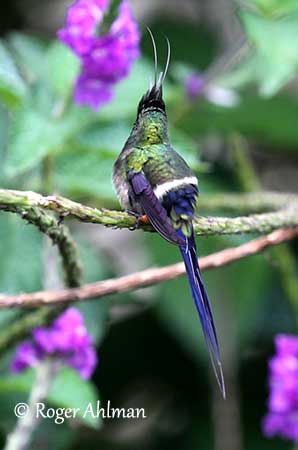
The adult female has coppery green upperparts with white rump band. The underparts are black with white patch on flanks. We can see a white malar streak contrasting with the dark plumage. The tail is short and slightly forked, with bluish-black rectrices and white tips.
On the head, the long, wire-like crest is absent, and we can see only some short feathers on the crown.
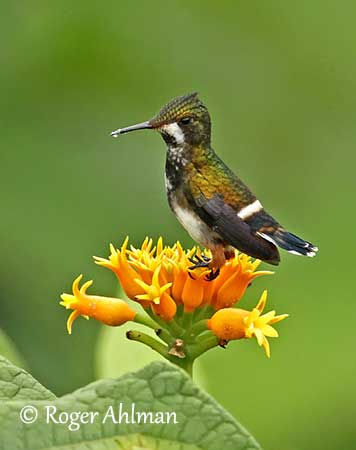
The immature resembles adult female.
RANGE:
The Wire-crested Thorntail is found in E Colombia (W Meta), E Ecuador and NE Peru (S to Puno). There are some records from adjacent Bolivia.
HABITAT:
The Wire-crested Thorntail frequents humid forests and forest edges in Ecuador where it occurs between 600 and 1200 metres of elevation.
CALLS AND SONGS: SOUNDS BY XENO-CANTO
The Wire-crested Thorntail gives short, quiet, liquid “tew” while feeding on nectar at flowers.
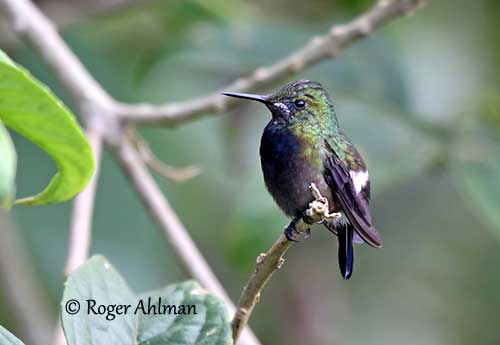
BEHAVIOUR IN THE WILD:
The Wire-crested Thorntail feeds primarily on nectar, and also takes some arthropods.
The nectar is taken from brightly coloured small flowers with high sugar content. It especially favours flowering Inga trees in foothills.
It weaves like a bee while hovering in front of flowers, using its long tongue to lick at the nectar. It may sometimes hang on the flower for feeding.
By feeding from tubular-shaped flowers that exclude both bees and butterflies, the Wire-crested Thorntail actively participates in pollination.
However, some invertebrates are taken too, such as insects and small spiders. They are mainly eaten during the breeding season. Insects are caught in flight by hawking, or taken from the vegetation or from spider webs.
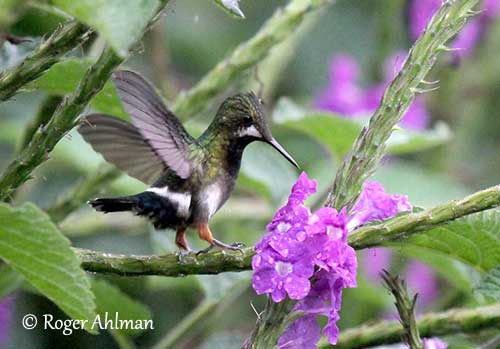
Like other Trochilidae, the Wire-crested Thorntail male defends aggressively its feeding areas. It chases away both hummingbirds and large insects. It performs threat displays such as flights and intimidation displays. The territory is defended by warning signals and threatening flights. Physical combats may occur sometimes.
During the breeding season, the male may mate with several females, but it does not take part in nesting duties.
It performs aerial displays to attract the females, flying in U-shaped pattern in front of them. It leaves the female after the copulation, but she may also mate with other males. The female selects the nest-site and builds the nest alone.
The Wire-crested Thorntail is probably sedentary in its range.
It hovers in front of flowers while feeding on nectar, and is similar to a bee.
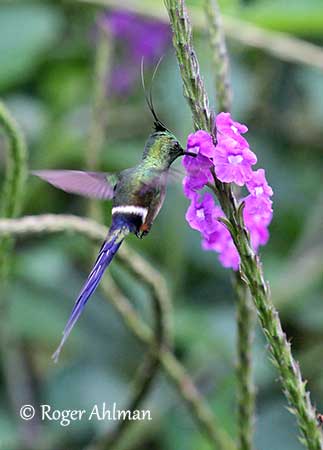
REPRODUCTION OF THIS SPECIES:
The Wire-crested Thorntail female builds the nest in shrub, bush or tree. It is a cup-shaped structure made with woven plant fibers. Green moss is added to the outer part of the nest as camouflage. The cup is lined with soft materials such as animal hair, down and finer plant fibers. The structure is strengthened by spider webs and some sticky material. It is usually built on fine, low, horizontal branch.
The female lays two white eggs and incubates alone. At hatching, the chicks are blind, motionless and naked. The female feeds them by regurgitation of partially-digested insects. The food is pushed down into the chick’s stomach.
She broods them during 1-2 weeks, and they are left alone at night after 12 days. They leave the nest about 3 weeks after hatching.
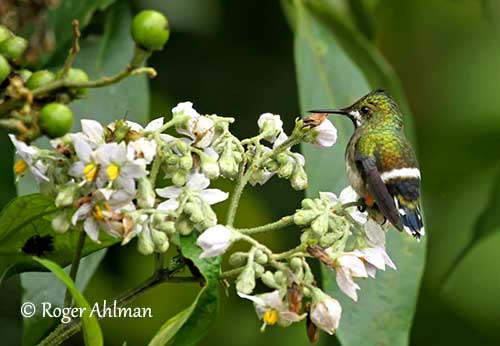
PROTECTION / THREATS / STATUS:
The Wire-crested Thorntail is threatened by habitat loss through deforestation in the Amazon basin for cattle ranching and agriculture (soy production).
The population size is unknown and the species is uncommon in the range.
The Wire-crested Thorntail is currently listed as Near Threatened.
